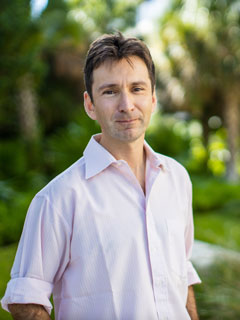Marine biologist documents the impacts of climate change
(2021)
In his travels around the world to survey and map coral reefs, Sam Purkis, a professor at the Rosenstiel School of Marine and Atmospheric Science, has witnessed firsthand the devastating impact of global warming.
Sam Purkis took his first trip to the remote coral reefs of the Chagos Archipelago 15 years ago, when he was a graduate student learning how to assess the health of these fragile ecosystems.
He was so enamored by the beauty of this pristine reef system in the middle of the Indian Ocean that Purkis became the United States’ lead of the Chagos Conservation Trust. Along with like-minded partners and organizations, the trust petitioned for the Chagos Archipelago to be declared a no-take marine protected area, a feat that was accomplished in 2010.

But now, just as a report on the health of the Chagos reefs is released, Purkis recalls how devastated he and a team of researchers were, as they watched these breathtaking reefs turn white from a climate-change related bleaching, which is ravaging corals around the world.
“It was heartbreaking,” said Purkis, noting that today the Chagos, which is situated more than 900 miles south of India and 370 miles south of the Maldives, contains only a fraction of the coral it had in 2015. “We’ve lost 50 percent of the world’s coral reefs in the last 40 years and we could lose the remaining ones in the next 10 years with the increased frequency of coral bleaching and overfishing,” he added.
Purkis, a professor and chair of the Department of Marine Geosciences at the University of Miami Rosenstiel School of Marine and Atmospheric Science, returned to the Chagos in 2015 in collaboration with the Khaled bin Sultan Living Oceans Foundation, an organization where he serves as chief scientist. After his initial trip as a student, Purkis returned as a professor, and was elated to see that the massive reef—including Earth’s largest atoll—was thriving and teeming with life.
“The marine protected area was having a great effect and the diversity and biomass of the reef fish was optimal,” said Purkis, who led the satellite-mapping component of the Living Oceans Foundation’s decade-long, 15-nation, 1,000 reef Global Research Expedition, which ended with the Chagos trip. “It seemed as vibrant and healthy as I remembered it, and it certainly would have been a contender for one of the best reefs on Earth.”
Yet just before his trip concluded, Purkis and 20 other scientists witnessed the harsh reality of climate change, which is threatening the livelihood of coral reefs across the planet. In their last week, the majority of the breathtaking corals began to bleach right before their eyes. Coral bleaching is a phenomenon that happens when water temperatures get too warm, stressing the benthic organisms to the point that they expel the symbiotic algae that support them. Because of rising temperatures across the planet, both local and global bleaching events have become more common in recent years, Purkis lamented.
All photos courtesy Khaled Bin Sultan Living Oceans Foundation
A full report, which documents the health of the Chagos Archipelago prior to the 2015 bleaching, was published recently, and includes detailed information on the state of benthic and reef fish communities at that point. Purkis contributed to the report, which was spearheaded by Renée Carlton, a marine ecologist for the Foundation who is also an alumna of Rosenstiel. Purkis said reports from every stop on the Global Reef Expedition offer critical information as a baseline for scientists and environmentalists to gauge the effects of climate change and other threats to coral reefs around the world, including those in the Bahamas, Jamaica, Colombia, French Polynesia, and Australia.
“It was important to go to the Chagos Archipelago prior to the bleaching since the Archipelago is like a natural laboratory because it is so remote,” he explained. “There’s very little evidence of heavy human impacts, and if you’re going to conserve something, you need to know what it is and what you’ve got.”
Purkis specializes in mapping and surveying coral reefs around the world. He does this by using satellite images and “ground-truthing,” a technique that involves acquiring high-definition underwater video and seabed samples to help verify that the satellite images are accurate.
But there are other methods needed to understand the full health of a reef, Purkis said. He also looks at the abundance of reef fish, as well as the myriad of other organisms which make the reef their home—including apex predators, like sharks—to assess the overall vitality of the ecosystem.
Despite the bleaching, Purkis said the entire Chagos expedition underscored the idea that when nations commit to safeguarding these underwater rainforests—and designating them as part of a marine protected area—it can ensure that the reef system, as well as the diverse marine life that flourish there, are shielded as well as possible from the harmful impacts of humans.
“If we can save reefs, large-scale marine protected areas are the best weapon we have,” he said.
He added that anything people can do to reduce the effects of global warming will also help coral reefs. Some of these include driving electric cars, eating less meat, not buying wild fish caught on reefs like snapper and grouper, and using less plastic.
A report on the entire Global Reef Expedition—the largest coral reef survey and mapping voyage ever completed, according to the foundation—will be released soon, according to Purkis. Meanwhile, he noted that the reefs in Chagos, as well as the coral reefs in French Polynesia, were some of the healthiest he saw during the 10-year journey. While the coral reefs in the Caribbean appeared to be struggling the most.